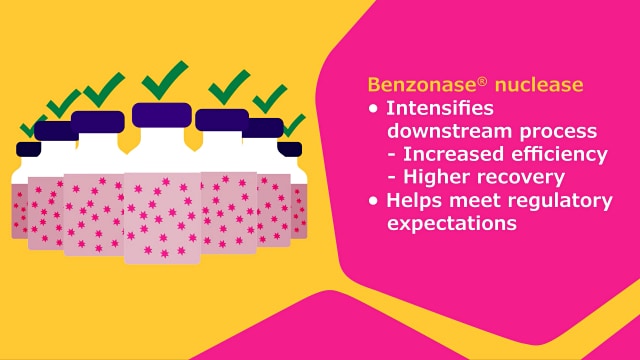Endonuclease

Endonuclease enzymes are used to reduce the level of nucleic acid contamination in bioprocessing workflows and research applications by cleaving DNA and RNA into smaller fragments. While a wide variety of natural sources are available, these endonuclease formulations can pose a challenge, however, as they may contain protease activity and viral contaminants.
Benzonase® endonuclease, a genetically engineered nuclease from Serratia marcescens, eliminates the risk of using naturally derived endonucleases and can degrade all forms of DNA and RNA. When used under appropriate reaction conditions, Benzonase® endonuclease will degrade all forms of DNA and RNA (single stranded, double stranded, linear, and circular) to oligonucleotides of approximately three to five base pairs in length. It has an exceptionally high level of specific activity without any detectable proteolytic activity.
With some manufacturing templates, use of a salt concentration above physiological levels (200mM NaCl) can be beneficial. Benzonase® Salt Tolerant endonuclease enables use of salt concentrations from 200mM to 1000mM NaCl for the midstream lysis and DNA digestion step during adeno-associated virus (AAV) vector production. This new addition to the Benzonase® portfolio is compatible with all tested detergents including Deviron® detergents, which are an alternative to Triton™ X-100.
Learn more about bioprocessing and research applications of Benzonase® endonuclease.
Products
Popular Filters
Products
Bioprocessing Applications
Benzonase® endonuclease is well-suited for stringent bioprocessing applications. It degrades nucleic acids well below the 200 base pair fragment size required by the World Health Organization (WHO) and US Food and Drug Administration (FDA), is released under GMP IPE-PQG conditions, and has a Drug Master File in place with the FDA which can be cited in regulatory filings.
It is effective across a wide range of operating conditions and applications including:
- Purification of viral vaccines and viral vector vaccines
- Purification of cell and gene therapies
- Purification of oncolytic viruses
- Removal of DNA and RNA from proteins and other biologicals
- Removal of host cell DNA
Three versions of IPEG PQG GMP Benzonase® endonuclease are available to meet different manufacturing needs. All are part of the Emprove® program that facilitates preparation of documents for regulatory submissions (Table 1).
Benzonase® endonucleases are prepared in the E. coli W3110 expression system and pose a minimal risk of viral contamination.
- Benzonase® endonuclease Emprove® Expert
- Benzonase® endonuclease Safety Plus Emprove® Expert is produced in a chemically defined medium and each batch is tested for the absence of adventitious viruses and mycoplasma.
- Benzonase® Salt Tolerant endonuclease is also produced in a chemically defined media and each batch is tested for mycoplasma; on demand testing for adventitious viruses is available.
Are you interested in a Benzonase® Sample? If yes, click the button below to learn more.
Research Applications
Benzonase® endonuclease can be used for a variety of research applications including:
- Removal of host DNA from microbiome samples
- Improvement of microbial taxa identification for microbiome studies
- Prevention of clumping during vaccine research
- Reduction of lysate viscosity during recombinant protein extraction workflows, leading to improve yield of the target protein
A variety of high purity, high concentration Benzonase® endonuclease options are available.
Benzonase® endonuclease is also available packaged with protein extraction reagents to further facilitate workflows.
- BugBuster® Master Mix: BugBuster® protein extraction reagent with Benzonase® endonuclease and rLysozyme solution
- BugBuster® HT Protein Extraction Reagent: BugBuster protein extraction reagent and Benzonase® endonuclease
- CelLytic™ B Plus Kit: lysozyme, Benzonase® endonuclease, and protease inhibitors
Related Product Resources
- Data Sheet: Benzonase® Salt Tolerant endonuclease Emprove® Expert
The best-in-class solution for nucleic acid removal at high salt concentrations.
- Technical Poster: AAV process intensification using high salt lysis & Benzonase® Salt Tolerant endonuclease
The overall process yield of adeno-associated virus (AAV) manufacturing is a major concern for biotherapeutic manufacturers
- Family Portfolio Flyer: Explore The Benzonase® endonuclease Portfolio
Ensuring efficiency and regulatory compliance — The smart solution for DNA removal in biopharmaceutical production
- Technical Article: AAV Process Intensification Using High Salt Lysis and Salt Tolerant Endonuclease
Production of adeno-associated virus (AAV) vectors includes a midstream step that combines cell lysis and nuclease treatment.
- Flyer: Deviron® 13-S9
Detergent, EMPROVE® EXPERT
- Data Sheet: What Does it Mean Switching from Benzonase® Endonuclease Emprove® Expert to Benzonase® Endonuclease Safety Plus Emprove® Expert
Optimization of Benzonase® endonuclease use in virus purification.
- Data Sheet: Optimization of Benzonase® Endonuclease Use in Virus Purification
Benzonase® endonuclease— the smart solution for DNA removal in biopharmaceutical production has proven its value for over 30 years.
- Brochure: Benzonase® Endonuclease
Balancing efficiency and regulatory compliance—the smart solution for DNA removal in biopharmaceutical production.
- Technical Article: Benzonase® Nuclease Q&A
This page lists nine frequently asked questions and answers about Benzonase® Nuclease.
- Technical Article: Removing DNA and RNA Using Benzonase® Endonuclease During Viral Production
Benzonase®endonuclease efficiently removes nucleic acid contaminants from viral production, crucial for cell and gene therapies and vaccines.
To continue reading please sign in or create an account.
Don't Have An Account?

